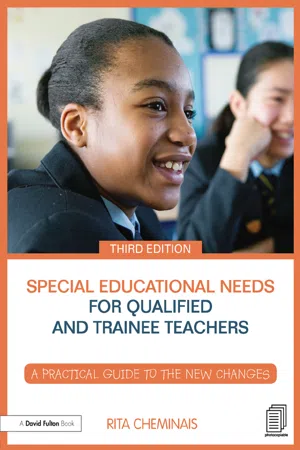
Special Educational Needs for Qualified and Trainee Teachers
A practical guide to the new changes
- 146 pages
- English
- ePUB (mobile friendly)
- Available on iOS & Android
Special Educational Needs for Qualified and Trainee Teachers
A practical guide to the new changes
About This Book
This completely revised and updated edition, previously published as Special Educational Needs for NQTs and TAs, addresses the latest Teachers' Standards, and their application in meeting the most recent developments and changes in the special educational needs system and the new SEN Code of Practice.
Essential reading and an invaluable guide for all qualified, newly qualified and trainee teachers, this highly practical text relates to those accessing SEN training via teaching school alliances, as well as Higher Education.
Full of tips and strategies on how to meet the needs of a diversity of children and young people with special educational needs, in a range of educational settings, chapters cover:
- the latest Teachers' Standards aligned to the most recent SEND changes
-
- the revised SEN Code of Practice, the Children and Families Act, and the Equality Act and its related Duties
- teaching schools, specialist leaders of education in SEN, and new training models for building teacher capacity in SEN
- how to meet the latest OFSTED inspection requirements for SEND
- what works best in the effective teaching of pupils with SEN and those eligible for the pupil premium
Featuring useful checklists, templates and photocopiable, downloadable resources to support professional development in SEN, this practical resource contains a wealth of valuable advice, in addition to signposting to further information.
This no-nonsense, down-to-earth authoritative text will provide essential reading for all experienced qualified, newly qualified and trainee teachers, as well as to those delivering SEND training in Higher Education, local authorities, and in teaching schools and their alliances.
Frequently asked questions
Information
CHAPTER 1 Working within the law and frameworks for SEND
- Demystifying the terminology
- Legislation and developments in SEND from 2010 to 2014
- The Children and Families Act 2014, Part 3
- The draft 2014 SEND Code of Practice (0 to 25)
- The Equality Act 2010 and its related Duties
- Ofsted inspections and SEND
- Teachers’ professional development for SEND
- The concept, use and impact of the pupil premium
Demystifying the terminology
The definition of SEND
- has a significantly greater difficulty in learning than the majority of others of the same age; or
- has a disability which prevents or hinders him or her from making use of educational facilities of a kind generally provided for others of the same age in mainstream schools or mainstream post-16 institutions.
(DfE 2014g: 4 xi–xii)
The definition of disability
Examples of disabilities
- sensory impairments (e.g. visual impairment (VI), hearing impairment (HI) and multi-sensory impairment (MSI));
- physical impairments or illnesses that affect mobility, dexterity or control of movement (e.g. arthritis, multiple sclerosis, stroke);
- developmental conditions (e.g. dyslexia, dyspraxia, autistic spectrum);
- progressive diseases (e.g. motor neurone disease, muscular dystrophy, dementia, lupus);
- illnesses with impairments with fluctuating or recurring effects (e.g. myalgic encephalitis (ME), chronic fatigue syndrome (CFS), epilepsy, diabetes);
- mental health conditions and mental illnesses (e.g. depression, eating disorders, obsessive compulsive disorder (OCD), schizophrenia, bipolar affective disorders, self-harm);
- HIV infection;
- cancer;
- facial disfigurements.
Legislation and developments in SEND from 2010 to 2014
The Children and Families Act 2014, Part 3
- General Public Sector Equality Duty (PSED) – eliminate unlawful discrimination, harassment and victimisation; advance equality of opportunity; foster good relations.
- Specific Duties – publish information to show compliance with the General Duty; prepare and publish specific and measurable equality objectives every four years.
- – identification of SEND early with support put in place quickly;
- – staff to know and understand SEND and have the skills to meet the needs of pupils with SEND;
- – raise aspirations through an increased focus on outcomes for pupils with SEND;
- – parents better informed about what local schools, colleges, the LA and local services provide for pupils with SEND;
- – parents to have more of a say over the services being used;
- – Education, Health and Care (EHC) plan and an integrated assessment process for those children and young people aged 0–25 with more complex needs.
- – streamlined, quicker single assessment process, involving pupils with SEND and their families more;
- – EHC plan to replace SEND statements, focused on outcomes, bringing services together;
- – personal budgets for those with an EHC plan;
- – LAs and health services joint planning and commissioning, to meet the needs of pupils with SEND and their families;
- – LAs to publish their local offer;
- – mediation to resolve disputes and a tribunal system introduced, giving pupils with SEND the right to appeal if they are unhappy with their support and provision.
- the quality of leadership and management;
- the behaviour and safety of pupils;
- the quality of teaching;
- the achievement of pupils.
- – the extent to which the education provided by the school meets the needs of pupils who have a disability for the purposes of the Equality Act 2010, and who have SEND;
- – spiritual, moral, social and cultural (SMSC) development of pupils at the school.
Table of contents
- Cover Page
- Half-Title Page
- Title Page
- Copyright Page
- Table of Contents
- List of figures
- List of tables
- Acknowledgements
- List of Abbreviations
- Introduction
- 1 Working within the law and frameworks for SEND
- 2 Promoting good progress and outcomes for pupils with SEND
- 3 Adapting teaching to respond to the strengths and needs of pupils with SEND
- 4 Making accurate and productive use of assessment
- 5 Effective behaviour management to ensure a good and safe learning environment
- 6 Fulfilling wider professional development responsibilities
- Glossary
- References and further reading
- Index